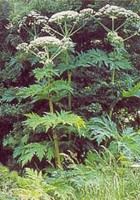
DO NOT TOUCH THIS PLANT - The plant exudes a clear watery sap, which sensitizes the skin to ultraviolet radiation. This can result in severe burns to the affected areas resulting in severe blistering and painful dermatitis. These blisters can develop into purplish or blackened scars. Proliferating populations in urban and suburban areas represents an increasing public health hazard. NOTE THAT THE SAP CAN CAUSE BLINDNESS IF IT ENTERS THE EYE(S).
obviously avoid physical contact with this plant
trail maintenance volunteers are the most vulnerable
the sap contains furanocoumarin that causes the skin to be photosensitive
it is an introduced perennial plant that can grow 4 – 6 metres (15 - 20 feet) tall
it belongs to the carrot or parsley family
it is similar to our native Cow-Parsnip
About this Plant
Giant Hogweed Giant Hogweed (Heracleum mantegazzianum) is a member of the parsley or carrot family, Apiaceae (Umbelliferae). It is characterized by its size and may grow to 5 to 7 metres in height. It is similar to Cow-Parsnip, (Heraculeum maximum or Heracleum lanatum). It has a stout dark reddish-purple stem and spotted leaf stalks. The stalks and stem produce sturdy pustulate bristles. The stem and stalks are hollow and the stems may be 5 to 10 cm in diameter. The compound leaves of giant hogweed may reach breadths of over one metre. Each leaflet is deeply incised. The inflorescence (flower cluster) is a broad flat-topped umbel composed of many small white florets. Each inflorescence/umbel may attain a diameter of 0.7 m.
Giant hogweed is native to the Caucasus Mountains and southwestern Asia. It was introduced to the gardens of Europe, the United Kingdom, Canada and the United States. It readily escaped and has naturalized in many of the places where it was first introduced. Growing along streams in Ontario, on Vancouver Island, and in Great Britain it forms a dense canopy out-competing native riverbank species and results in an increase in soil erosion along the stream banks where it occurs.
Giant hogweed often grows in wet areas but may colonize a wide variety of habitats such as along roadsides, other rights-of-way, vacant lots, streams and rivers.
Think you've spotted giant hogweed? Here's how to tell; CTV
Ontario Weeds: Giant hogweed; Ministry of Agriculture and Food
Giant Hogweed; Ontario Invading Species